Supporting Children with Autism in Group Settings: An Evidence-Based Approach
Navigating group activities can be challenging for children with autism, but Applied Behavior Analysis (ABA) provides effective strategies to promote social development. This article explores how ABA therapy techniques can be employed to enhance social interaction, awareness, and participation, enabling children on the autism spectrum to engage confidently and meaningfully in group environments.
Understanding ABA Therapy and Its Role in Promoting Social Skills
What is ABA therapy?
Applied Behavior Analysis (ABA) therapy is an evidence-based approach that focuses on teaching specific behaviors through reinforcement strategies. It is widely used to support children with autism by helping them develop essential social, communication, and cognitive skills. ABA therapy programs are highly personalized, designed after comprehensive assessments to meet each child's unique needs.
How does ABA facilitate social skills development?
ABA therapy employs various techniques to improve social understanding and interaction. Structured learning environments and social stories are used to model appropriate social behaviors, such as eye contact, turn-taking, and recognizing social cues. Video modeling and role-playing activities expose children to real-life scenarios, helping them practice and understand social norms.
Positive reinforcement is a cornerstone of ABA, encouraging children to practice behaviors like sharing, cooperation, and emotional regulation repeatedly until they become natural. Group social skills training allows children to practice interaction with peers, promoting skills like effective communication, empathy, and teamwork. These group activities often include structured play and pretend scenarios that simulate everyday social situations.
To ensure these skills are not limited to a single environment, ABA programs involve parents, teachers, and caregivers in reinforcing behaviors across different settings. Visual supports, such as social stories and visual cues, help children connect spoken words with actions, strengthening their comprehension.
Why is ABA effective for children with autism?
Research consistently supports the efficacy of ABA therapy in enhancing social skills among children with autism. Early intervention, ideally between ages 2 and 6, produces the best results. These programs not only teach new skills but also aid in emotional regulation and increase opportunities for social inclusion.
Techniques such as Discrete Trial Training (DTT) and Natural Environment Teaching (NET) are employed to teach turn-taking, reciprocal communication, and problem-solving skills. For instance, DTT involves breaking down complex behaviors into smaller steps, using prompts and reinforcement to teach each component.
In addition, activities like matching games, puzzles, singing songs, reading stories, and sensory bins support various aspects of development, such as fine motor skills, vocabulary, and sensory processing.
ABA's adaptability enables it to be implemented in natural settings, including homes and community environments, facilitating skill generalization. Overall, ABA therapy offers a structured yet flexible framework to help children with autism develop crucial social competencies, fostering increased independence and social participation.
Strategies for Enhancing Social Skills in Group Settings
To help children participate successfully in group settings, implementing structured routines and visual supports is essential. These tools reduce anxiety and promote understanding, making social interactions smoother.
Incorporating social skills training through role-playing, group games, and emotional recognition exercises helps children learn and practice social norms. Peer-mediated strategies, where typically developing children serve as models and support, are particularly effective. Engaging family and caregivers in these activities reinforces learning outside therapy sessions.
Creating inclusive and adaptable environments with varied materials encourages positive interactions and friendships. Early, tailored intervention combined with consistent reinforcement and supportive feedback significantly boosts a child's confidence and ability to work with others.
By combining these practical techniques, children with autism can develop meaningful social connections and participate more fully in their communities.
Core Principles of ABA in Developing Social Abilities
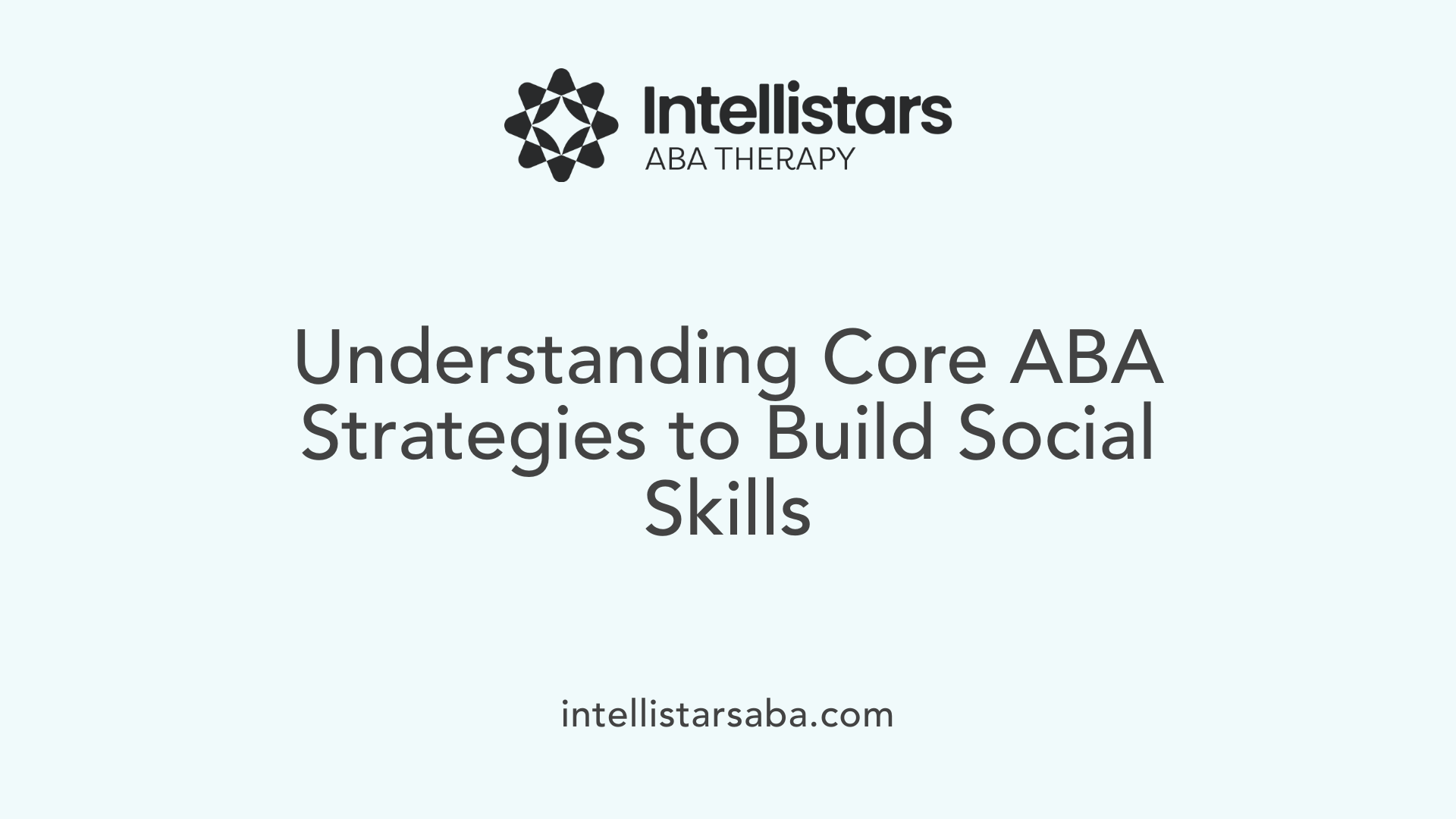
How are ABA principles applied to develop social skills in children with autism?
Applied Behavior Analysis (ABA) employs a variety of structured techniques aimed at nurturing social skills in children with autism. At its core, ABA breaks complex social behaviors into smaller, manageable parts through a process called task analysis. This allows children to learn specific skills like eye contact, turn-taking, and reading social cues step by step.
One of the primary strategies in ABA is positive reinforcement. When a child displays a desired social behavior, such as sharing or initiating a conversation, it is immediately rewarded with praise, a preferred activity, or tangible rewards. This encourages the child to repeat these behaviors, helping them to become habitual.
In addition to reinforcement, ABA utilizes prompts and modeling to teach social skills. Therapists may demonstrate a social behavior or give cues, gradually fading prompts as the child gains independence. Role-playing scenarios simulate real-life social interactions, providing children with practical experience in a controlled setting.
To ensure skills are used across different environments, ABA incorporates naturalistic teaching strategies. These strategies embed learning into daily routines, such as during playtime or mealtime, facilitating the transfer of skills from therapy sessions to everyday life.
Data collection is central to ABA, allowing therapists to track each child's progress meticulously. This data-driven approach ensures programs are tailored to the child's evolving needs, maximizing their social communication, emotional regulation, and interaction abilities.
Overall, ABA’s application in developing social skills involves a combination of structured teaching, positive reinforcement, modeling, role-playing, and ongoing assessment. This comprehensive approach effectively promotes meaningful and lasting improvements in social functioning for children with autism.
Implementing ABA for Social Skills in Group Activities
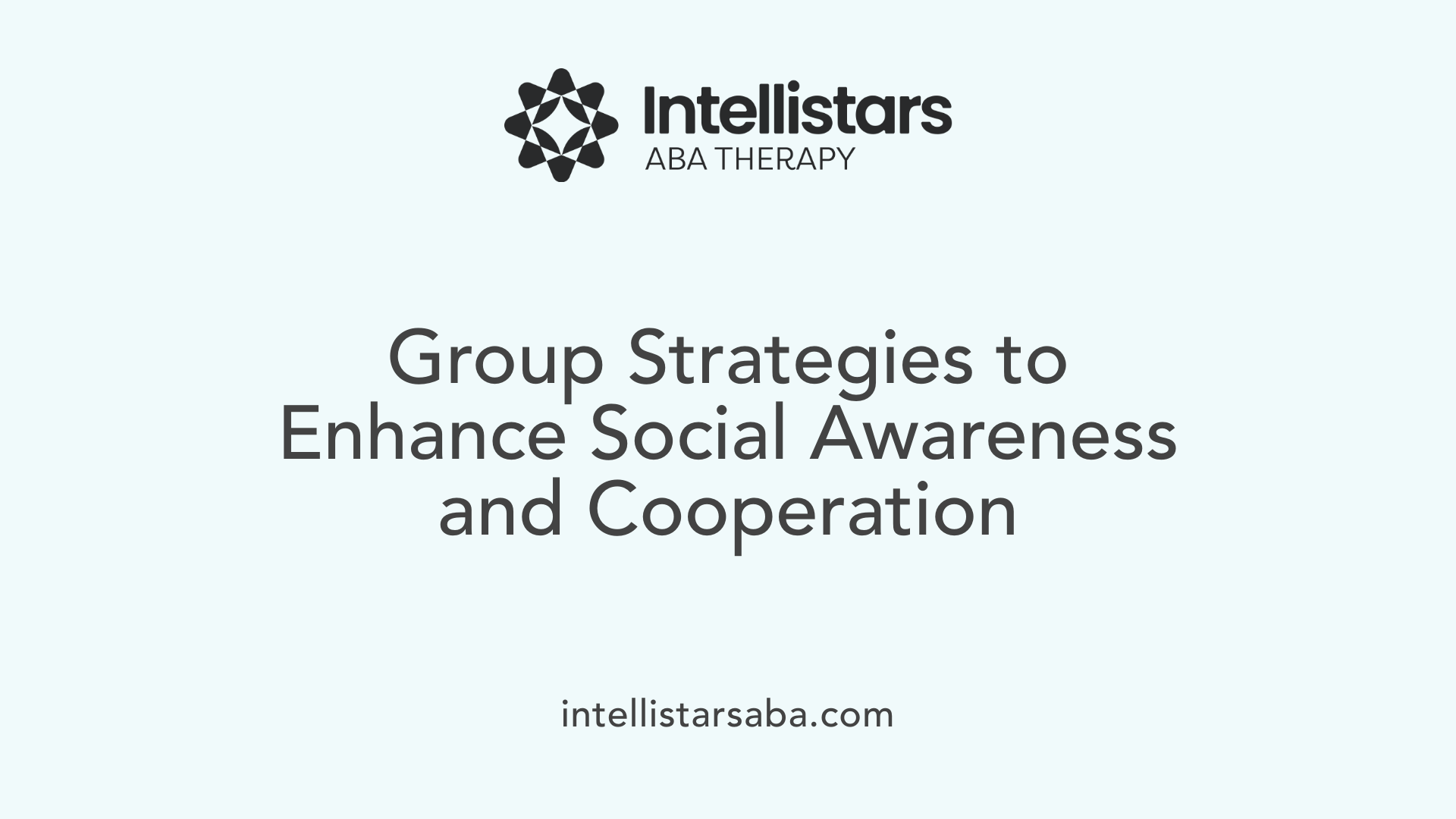
What methods are effective for teaching social awareness and social skills to children with autism?
Effective approaches in ABA therapy focus on practical, engaging activities that help children learn to navigate social environments. One of the main strategies involves using social stories and visual supports. These are simple, illustrated scripts that describe social situations, helping children understand what to expect and how to behave. Visual cues like pictures and routines make abstract concepts more concrete.
Role-playing and video modeling are also invaluable, enabling children to practice real-world scenarios in a safe setting. This hands-on practice helps them recognize social cues, develop appropriate responses, and build confidence in their interactions.
Group social skills training further enhances learning by providing children with opportunities to interact with peers. These sessions are structured to include activities like cooperative play, turn-taking, and sharing. By participating in a variety of social group activities, children can develop better communication skills, emotional regulation, and empathy.
To support natural engagement, ABA programs often involve peer-mediated strategies. For example, pairing children with neurotypical peers as models or mentors encourages spontaneous social interaction and provides real-life modeling of social norms.
Additional methods include social-emotional learning programs aimed at fostering skills like emotional regulation, empathy, and problem-solving. These programs, integrated within ABA sessions, help children understand their own feelings and others’ emotions, creating a foundation for meaningful relationships.
Ongoing assessment, coupled with collaboration among therapists, parents, and teachers, ensures that interventions remain tailored and effective. Adjustments based on individual progress maximize the chances of skill generalization across different settings and environments.
Overall, the integration of visual supports, structured role-play, peer interactions, and personalized strategies forms a comprehensive approach to teaching social awareness and skills to children with autism, promoting better social inclusion and quality of life.
| Method | Description | Example Use Case |
|---|---|---|
| Social Stories & Visual Supports | Visual aids explaining social behaviors and routines | Using pictures to teach greeting or sharing norms |
| Role-Playing & Video Modeling | Practice scenarios in simulated environments | Acting out bathroom routines or conflict resolution scenarios |
| Group Social Skills Training | Structured activities promoting peer interaction | Cooperative games emphasizing turn-taking and sharing |
| Peer-Mediated Strategies | Using peers as social models or mentors | Pairing children to engage in joint activities during therapy sessions |
| Social-Emotional Learning | Focused on understanding feelings and empathy | Discussing feelings after shared experiences |
This comprehensive approach ensures children with autism develop essential social skills, increasing their ability to connect, communicate, and thrive in various social settings.
Methods for Teaching and Reinforcing Social Cues and Behaviors
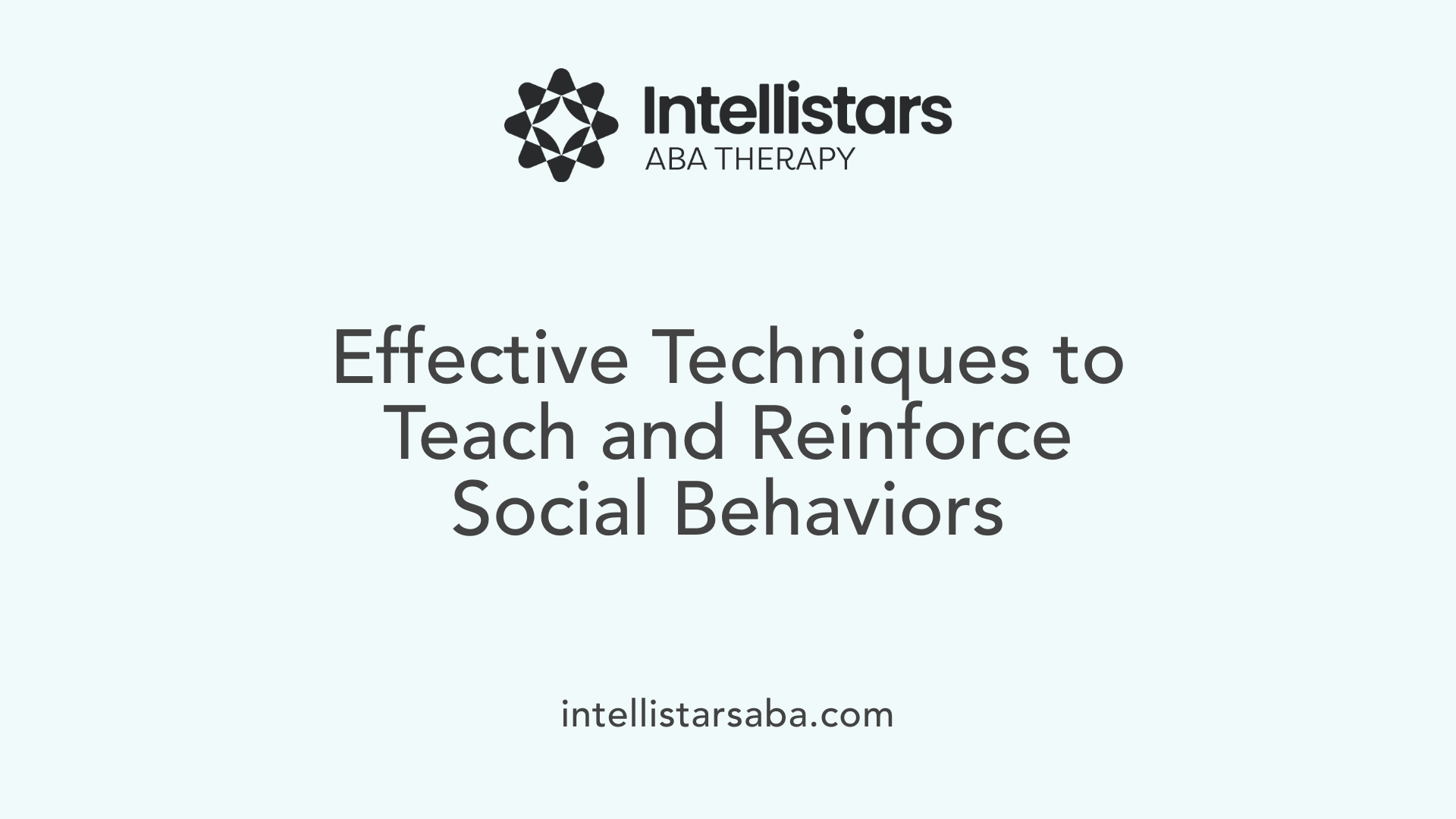
How can ABA therapy techniques improve social interaction skills in children with autism?
ABA therapy employs a range of structured techniques to help children with autism develop essential social skills. By focusing on teaching behaviors like making eye contact, initiating conversations, understanding emotions, and following social norms, ABA creates a supportive environment for learning.
One effective method involves role-playing and social stories. These tools simulate real-life interactions, allowing children to practice responses and understand social cues in a safe setting. For example, a social story might depict a scenario where a child shares toys or greets a peer, emphasizing the steps involved. Role-playing scenarios help children generalize these behaviors and become more comfortable in everyday interactions.
Video modeling and visual supports are also widely used. Video modeling involves showing children clips of peers or adults demonstrating desired behaviors, such as waving hello or taking turns. Visual supports, like pictures or cue cards, reinforce understanding of social concepts, making abstract ideas concrete and easier to grasp.
Positive reinforcement is central to ABA strategies. When children exhibit targeted behaviors, they receive immediate praise, tokens, or other rewards. This encouragement motivates them to repeat these behaviors consistently. Reinforcement can be tailored to each child's preferences, increasing motivation and the likelihood of skill retention.
ABA programs are personalized to each child's unique needs, often integrating social skill groups, natural environment teaching, and parent training. Group activities provide opportunities to practice turn-taking, sharing, and cooperative play, fostering real-world social competence.
In addition, involving parents and caregivers ensures that learned skills are reinforced beyond therapy sessions. They can create opportunities for social interactions at home, use reinforcement strategies, and model appropriate behaviors.
The effectiveness of ABA in teaching social skills is supported by research, showing that early intervention maximizes outcomes. With consistent practice and reinforcement, children with autism can improve their communication, emotional regulation, and social inclusion, helping them build meaningful relationships.
Supporting Emotional Regulation and Social Connections
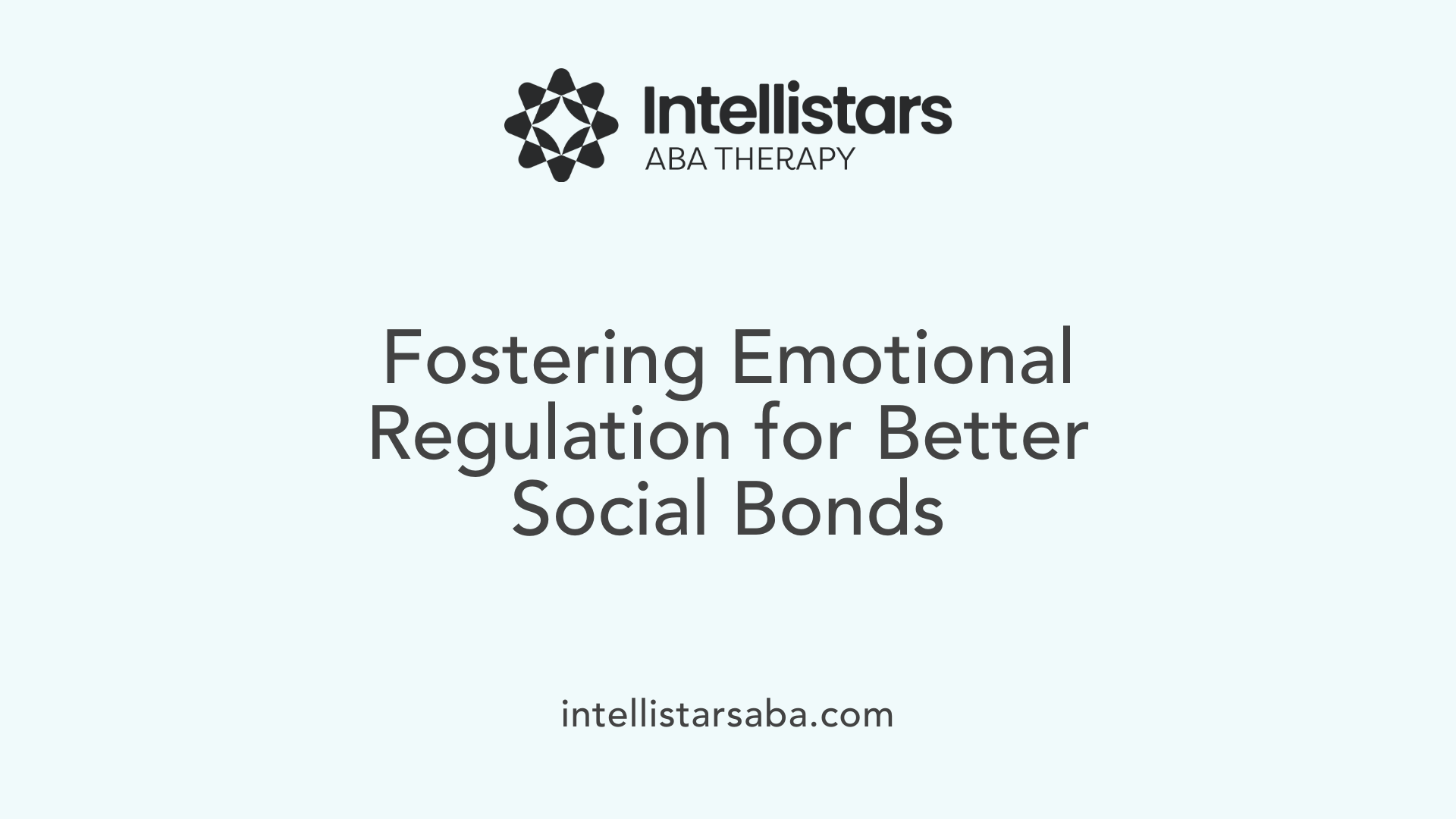
What role does emotional regulation play in social interactions?
Emotion regulation is essential for children with autism to navigate social situations successfully. When children can manage their feelings, they are more likely to engage positively with peers and adults. Effective regulation helps reduce instances of outbursts or withdrawal, allowing children to participate fully in group activities and develop meaningful relationships.
In ABA therapy, emotional regulation is often targeted through specific strategies such as teaching calming techniques, recognizing emotional cues, and practicing self-control during interactions. These skills are crucial in helping children understand their own feelings and respond appropriately to others’ emotions, fostering empathy and social understanding.
How does ABA incorporate conflict resolution and problem-solving?
ABA techniques emphasize teaching children how to handle conflicts constructively. Using role-playing and social stories, children learn appropriate ways to express their feelings, negotiate disagreements, and resolve issues peacefully. These activities help children develop problem-solving skills, patience, and empathy—traits that support healthier social relationships.
Conflict resolution in ABA often involves breaking down social problems into manageable steps, practicing responses, and reinforcing successful interactions with praise and reward. This structured approach encourages children to apply what they learn across various settings, promoting consistency and lasting skill development.
How are families and caregivers involved in promoting social skills?
Parents and caregivers play a vital role in reinforcing social skills outside of therapy sessions. They are encouraged to create opportunities for social interactions, such as inviting friends or siblings to play cooperatively. Using positive reinforcement—praising and rewarding desired behaviors—helps children understand which behaviors are expected and appreciated.
Caregivers are also guided to model appropriate social behaviors, use visual supports, and employ consistent routines. This collaborative approach ensures that skills learned in therapy are generalized and maintained across different environments, increasing the child's confidence and competence in social settings.
Strategies Supporting Children During Group Activities
Supporting children with autism in group activities requires a structured and predictable environment. Visual supports like schedules, social stories, and clear rules help reduce anxiety and enhance understanding of routines. Facilitating positive peer interactions through modeling, pairing children with role models, and small, guided groups encourages social skill development.
Sensory accommodations—including quiet spaces, noise-canceling headphones, and sensory tools—help manage overload and emotional distress. Explicit teaching of social cues, empathy, and reciprocity, supported by visual cues and positive reinforcement, promotes desired social behaviors.
Collaboration with families and professionals ensures consistency and helps tailor strategies to each child's needs, creating a supportive environment that nurtures social connections.
| Strategy | Description | Benefits |
|---|---|---|
| Visual Supports | Schedules, social stories, clear rules | Reduce anxiety, enhance understanding |
| Peer Modeling | Peers demonstrate social behaviors | Encourage imitation and learning |
| Sensory Accommodations | Quiet spaces, sensory tools | Manage sensory overload, emotional regulation |
| Social Skills Instruction | Role-playing, explicit teaching | Practice and reinforce social cues |
| Family Involvement | Reinforcing skills at home | Generalize skills across settings |
Supporting social and emotional development in children with autism through ABA therapy involves a combination of structured strategies, involvement of families, and tailored activities. These efforts promote emotional regulation, conflict resolution, and meaningful social connections, ultimately fostering a stronger sense of belonging and self-esteem.
Long-term Benefits of ABA in Social Skills Development
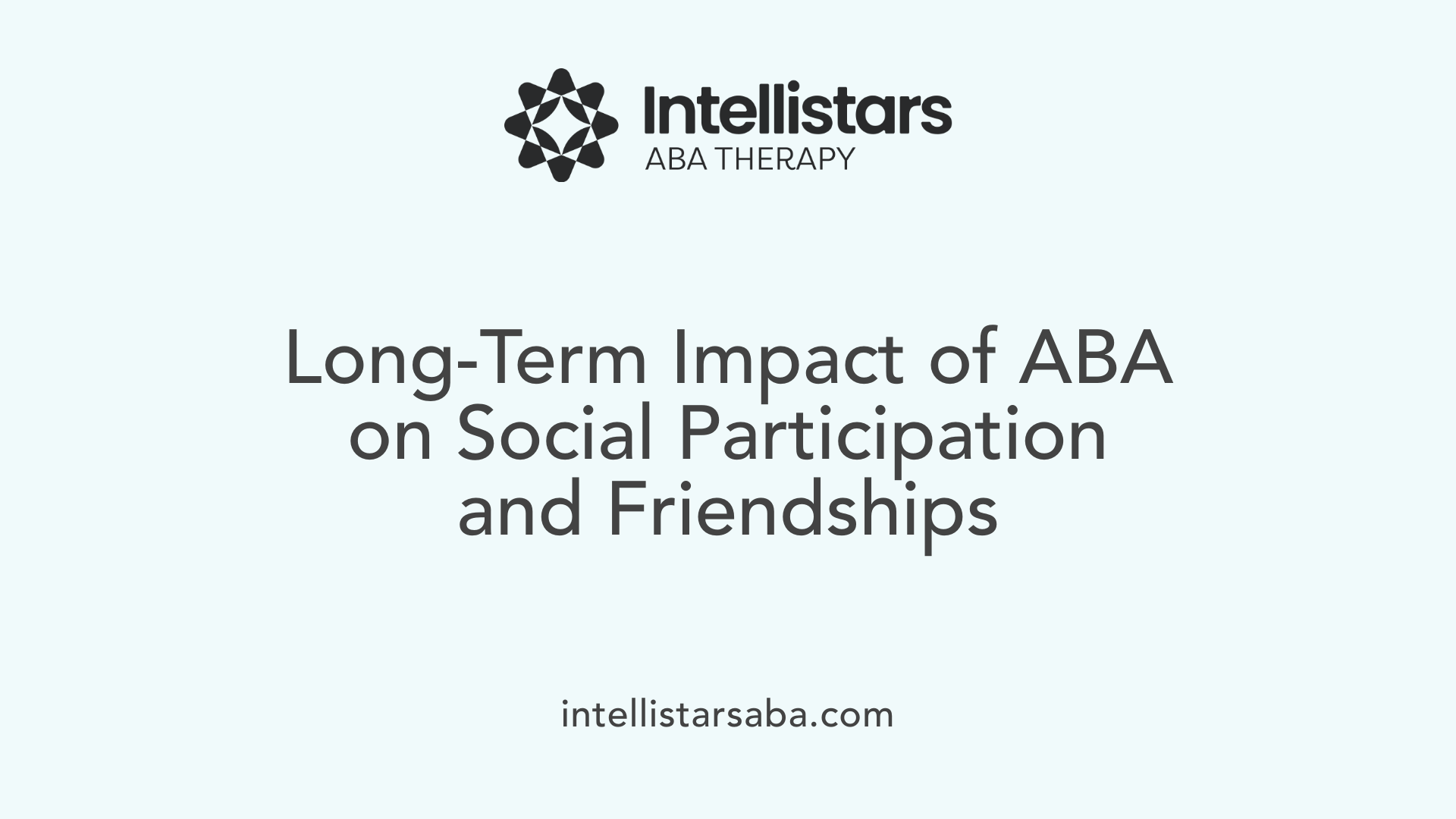
How does ABA therapy enhance social participation and interaction skills?
Applied Behavior Analysis (ABA) therapy has shown to be highly effective in improving social skills among children with autism. By using structured, personalized strategies such as reinforcement, role-playing, and social stories, ABA helps children learn and practice essential social behaviors like sharing, turn-taking, eye contact, and understanding social cues.
One of the primary benefits is increased confidence in social settings. Children participate in group activities designed to simulate real-life interactions, which gradually helps them navigate different environments smoothly. These sessions are often supplemented with social skills training groups where kids engage in cooperative play and learn teamwork, further promoting their social inclusion.
The earlier the intervention, ideally between ages 2 and 6, the better the outcomes. Early ABA programs foster foundational social skills that serve as building blocks for later social participation. Over time, children become more comfortable in social environments, reducing feelings of isolation and increasing opportunities for community engagement.
How does ABA support the development of friendships and social networks?
Through consistent reinforcement and guided interactions, ABA encourages children to develop meaningful relationships. Social skill groups provide a safe space for practicing important skills such as emotional regulation, empathy, and effective communication.
Activities like role-playing, pretend play, and cooperative games teach children how to initiate and maintain conversations, share interests, and resolve conflicts healthily. These experiences are vital for friendship formation and expanding social networks.
Parents are also involved in reinforcing social skills at home by inviting peers or siblings for playdates, practicing turn-taking, and praising positive interactions with peers.
By fostering these skills consistently, children with autism can build lasting friendships, which significantly enhance their social well-being and sense of belonging.
What is the impact of early intervention on long-term social development?
Implementing ABA therapy during early childhood is crucial because it takes advantage of the brain's developmental plasticity. Early intervention helps establish social behaviors before maladaptive patterns become ingrained.
Research indicates that children who start ABA therapy early show greater improvements in social participation, communication, and emotional regulation. They are more likely to attend social activities, form peer relationships, and navigate social norms successfully.
In addition, early ABA intervention supports families by equipping them with strategies to reinforce social skills in daily routines, thereby creating a consistent environment for social learning.
This proactive approach not only accelerates skill acquisition but also mitigates future social and behavioral challenges, offering children a better chance at social inclusion and a richer, more connected life.
| Aspect | Description | Benefits |
|---|---|---|
| Social Participation | Engagement in school, community, and peer activities | Increased confidence, social confidence, inclusion |
| Friendship Development | Building and maintaining friendships | Emotional support, social bonds, shared experiences |
| Impact of Early Intervention | Starting ABA early during critical developmental windows | Better long-term social skills, reduced isolation |
This comprehensive approach through ABA therapy fosters social growth that lasts well beyond childhood, supporting children in forming meaningful relationships and participating fully in their communities.
Empowering Social Growth Through ABA-based Interventions
Incorporating ABA therapy techniques into group activities offers a pathway to meaningful social development for children with autism. By systematically teaching, reinforcing, and generalizing social skills, ABA supports children in understanding social cues, building friendships, and participating confidently in various social settings. The involvement of families, educators, and peers further enriches this process, ensuring that children receive consistent support and opportunities to thrive socially. Ultimately, ABA provides a proven framework for nurturing social competence, fostering greater inclusion, and empowering children with autism to navigate their social worlds with increased independence and joy.
References
- Developing Social Skills Through ABA Therapy for Autism
- Building Social Skills Through Group ABA Activities
- 7 Real-World ABA Therapy Examples, Activities & Their Benefits
- Harnessing ABA Therapy for Social Skills Development in Autism
- Applied Behavior Analysis (ABA) for Children With Autism
- Building Social Awareness in Children with Autism - Aim Higher ABA
- The effectiveness of applied behavior analysis program training on ...
- Applied Behavior Analysis (ABA) | Autism Speaks
- Using ABA to Improve Social Skills in Children with Autism
- Applied Behavior Analysis in Children and Youth with Autism ...






